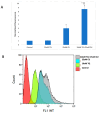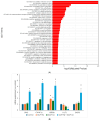Synergistic Anti-Cancer Effects of Curcumin and Thymoquinone Against Melanoma
- PMID: 39765900
- PMCID: PMC11672881
- DOI: 10.3390/antiox13121573
Synergistic Anti-Cancer Effects of Curcumin and Thymoquinone Against Melanoma
Abstract
Combining anti-cancer agents in cancer therapies is becoming increasingly common because of their improved efficacy, reduced toxicity, and decreased risk of resistance development. Melanoma, a highly aggressive form of skin cancer characterized by limited treatment options due to chemoresistance, poses a considerable challenge for effective management. Here, we test the hypothesis that dietary supplements such as thymoquinone (TQ) and curcumin (CU) cooperatively modulate cancer-associated cellular mechanisms to inhibit melanoma progression. Through a series of in vitro experiments utilizing the A375 melanoma cell line, including assessments of cell viability, apoptosis, multicellular tumor spheroid models, reactive oxygen species (ROS) quantification, metabolomics analysis, and RNA sequencing, we established that the combined application of TQ and CU exhibited superior anti-tumor effects compared to their individual use. Our results indicate that the combination treatment significantly inhibited cell viability and induced apoptosis more effectively than either agent alone, with optimal synergy observed at concentrations of 25 µM CU and 10 µM TQ against A375 cells. Additionally, the combination treatment markedly elevated ROS levels, selectively activating the mitochondrial apoptotic pathway via caspase-9. Differential gene expression analysis further revealed a unique synergistic effect of the combination treatment, with enhanced regulation of genes related to oxidative stress and apoptosis. Notably, pathways such as mitochondrial apoptotic signaling and redox homeostasis were more effectively influenced by the combination, with genes such as GPX3, CYP4F11, and HSPB8 cooperatively regulated. Overall, the findings suggest that, in combination, TQ and CU acts synergistically against melanoma; however, further experimental and clinical studies are required to confirm its therapeutic potential.
Keywords: RNAseq; cancer; curcumin; melanoma; thymoquinone.
Conflict of interest statement
The authors declare no conflict of interest.
Figures












Similar articles
-
Thymoquinone induces oxidative stress-mediated apoptosis through downregulation of Jak2/STAT3 signaling pathway in human melanoma cells.Food Chem Toxicol. 2021 Nov;157:112604. doi: 10.1016/j.fct.2021.112604. Epub 2021 Oct 7. Food Chem Toxicol. 2021. PMID: 34627931
-
Curcumin suppresses cell proliferation and triggers apoptosis in vemurafenib-resistant melanoma cells by downregulating the EGFR signaling pathway.Environ Toxicol. 2022 Apr;37(4):868-879. doi: 10.1002/tox.23450. Epub 2022 Jan 7. Environ Toxicol. 2022. PMID: 34994998
-
Thymoquinone Enhances the Effect of Gamma Knife in B16-F10 Melanoma Through Inhibition of Phosphorylated STAT3.World Neurosurg. 2019 Aug;128:e570-e581. doi: 10.1016/j.wneu.2019.04.205. Epub 2019 May 2. World Neurosurg. 2019. PMID: 31054338
-
Curcumin and quercetin synergistically inhibit cancer cell proliferation in multiple cancer cells and modulate Wnt/β-catenin signaling and apoptotic pathways in A375 cells.Phytomedicine. 2019 Jan;52:117-128. doi: 10.1016/j.phymed.2018.09.224. Epub 2018 Sep 28. Phytomedicine. 2019. PMID: 30599890
-
Thymoquinone (2-Isoprpyl-5-methyl-1, 4-benzoquinone) as a chemopreventive/anticancer agent: Chemistry and biological effects.Saudi Pharm J. 2019 Dec;27(8):1113-1126. doi: 10.1016/j.jsps.2019.09.008. Epub 2019 Sep 25. Saudi Pharm J. 2019. PMID: 31885471 Free PMC article. Review.
References
Grants and funding
LinkOut - more resources
Full Text Sources
Miscellaneous

